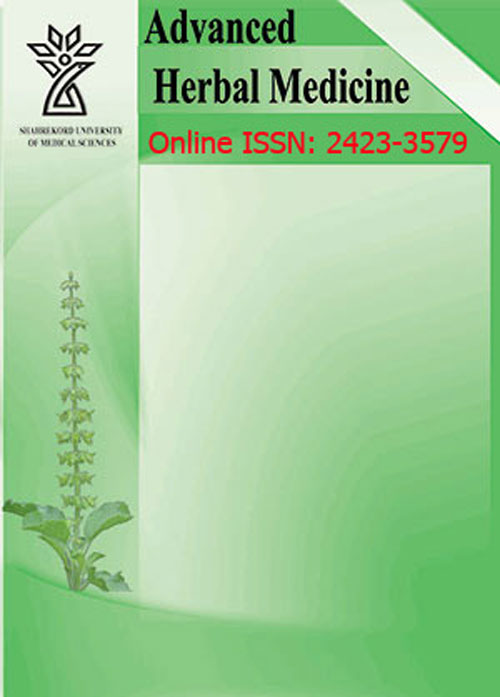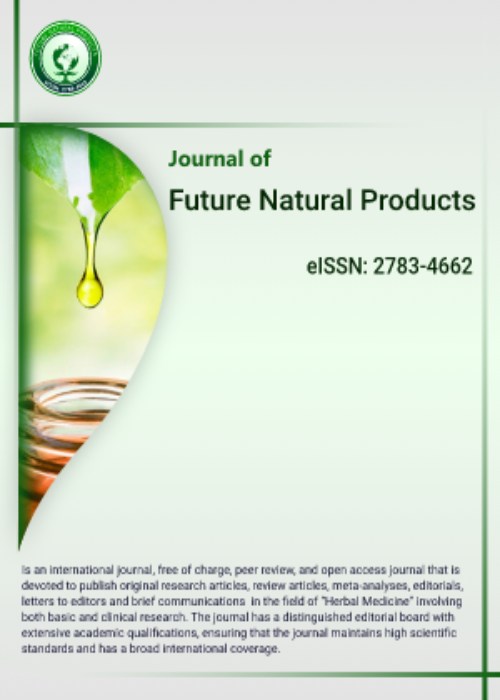فهرست مطالب

Future Natural Products
Volume:4 Issue: 3, Summer 2018
- تاریخ انتشار: 1397/06/10
- تعداد عناوین: 4
-
Pages 34-44Background and aimsCyclophosphamide (CP), is a widely used cytotoxic alkylating agent with antitumor and immunosuppressant properties. In spite of its therapeutic importance, a wide range of adverse effects including reproductive toxicity have been demonstrated following cp treatment in humans and experimental animals.The current report was designed to investigate the possible protective effect of Heracleumpersicum against cyclophosphamide(CP)-induced hepatotoxicity in rats.MethodsIn this experimental research 30 male albino Wistar rats, with body weights of 180-200 g were obtained. The animals were randomly assigned into five groups of 6 in each.Group 1 (control) group 2 (only receiving cyclophosphamide) and groups 3, 4, 5 (receiving cyclophosphamide with differentdoses ofmethanol extract of H.persicum). In order to induce liver toxicity in groups 2, 3, 4 and 5, CP was administered as a single dose (0.5 mg/kg), intraperitoneally and methanol extracts (0.5, 1 and 2 mg/Kg) wereadministered by gavage in 24-h cycles over a 21-day period.ResultsThe results showed that administration of CP induced hepatic damage associated with significant increase in the serum marker enzymes aspartate and alanine transaminases (AST, ALT) and alkaline phosphatase (ALP) level in the CP treated group in comparison with the control (p<0.05). In addition, it was revealed that CP-administration cause a significant decrease (p<0.05) in activity of catalase (CAT) and superoxide dismutase (SOD). However, groups which received the extract of H. persicum in association with CP represented significantly improved parameters.Conclusionthe results revealed that the methanol extract of H. pesicum has hepatoprotective effect against cyclophosphamide(CP)-induced toxicity in rats.Keywords: Heracleumpersicum, Antioxidant enzymes, Cyclophosphamid, Liver toxicity
-
Pages 55-63Background and aimsThe genus Artemisia is one of the largest and most widely distributed of the nearly 100 genera in the tribe Anthemideae of the Asteraceae (Compositae). 34 species of Artemisia have been reported in Iran. Several secondary metabolites characterize the chemical composition of the genus Artemisia. Therefore, the current study aimed to phytochemical Characteristics of Artemisia persica Boiss collected from the Farm and natural habitat of Ilam.MethodsThe aerial parts of plants were collected from Farm and Kabirkooh mountain. After extraction of Artemisinin, the analysis was performed with an HPLC system. Extraction of essential oil it was done by hydro distilled. Phytocomponents identified in Artemisia persica Boiss essential oils by GC/MS system.ResultsThe essential oil yield was reported in Kabirkooh mountain and Farm 0.92 % and 0.6%, respectively. The major oil compounds of samples of Artemisia persica Boiss collected were included: α-Pinene, 1,8-Cineole, (Z)-Sabinene hydrate, (E)-Pinocarveol, Pinocarvone, Artedouglasia oxide C, Laciniata furanone E, Artedouglasia oxide D, Artedouglasia oxide B. The Artemisinin was 2.7 ppm in the Kabirkooh mountain sample. However the Farm sample had 1.5 ppm.ConclusionsTo achieve the appropriate level of the target compounds it is important to considered an appropriate place for sampling.Keywords: Artemisia persica Boiss, essential oil, Artemisinin, Phytochemical
-
Pages 64-72Background and aimsStaphylococcus aureus and anaerobic gram-positive cocci, are medically the most important species in the genus Staphylococcus. Sometimes, the bacteria are called S. aureus. The constantly growing antibiotic-resistant bacterium is very important in treatments. The aim of this study is to evaluate the antimicrobial activity of ethanol extract from Citrullus colocynthis against the S. aureus resistant to antibiotics.MethodsS. aureus strains were isolated from the city of Zabol and C.colocynthis extract was prepared using rotary devices and the MIC and MBC were determined by microdilution method.ResultsThe results of this study showed that the extract from C. colocynthis inhibits the growth of bacteria in different concentrations, and that despite the relative strength of most species with different concentrations, the highest sensitivity was observed in concentrations of 10 and 20 mg/ml, in which is 100% bacteria were gone. C. colocynthis extract at a concentration of approximately 5 mg /ml had the highest inhibitory effect.ConclusionThe results showed high antimicrobial effects of ethanol extract of C. colocynthis, which can offer appropriate drug therapy.Keywords: Antimicrobial, Plant extract, C. colocynthis, S.aureus
-
Pages 79-87
Liver is the largest and most vital organ in human body and able to detoxify several chemical compounds. Acute liver failure (ALF) is a rare devastating process that can leads to urgent liver transplantation. In this study we introduce 3 children of a family with an accidental intoxication of Cassia Floribunda which causes ALF. The first case is a four-year-old girl with an icter's complaints and drowsiness after eaten plant in the garden while playing with her sister and friend 3 days ago. At the beginning her GCS was 10, vital signs were normal, sclera was icteric and pupil has normal size and was reactive to the light. Initial tests showed leukopenia, anemia, thrombocytopenia, increase of liver enzymes , coagulopathy , hypoglycemia. With diagnosis, fulminant liver deficiency and hepatic encephalopathy, the patient transferred to PICU and GCS reduced. her general appearance became better ,consciousness increased, lab test findings improvedand and discharged after 11 days.Second and third cases presented to emergency with similar complaints without icteric, vital signs and other examinations were normal . Initial tests reported reduced platelets, increase liver enzymes , Without hypoglycemia. treatment was started for patient by intravenous ranitidine and monitored in emergency . Two days after discharged. But in third case platelets increased.ALF in children is a serious problem that can lead to death or need to liver transplantation. When evaluate the causes of ALF, poisoning due to plants should be kept in.
Keywords: Acute liver failure, Cassia floribunda, senna, case series


